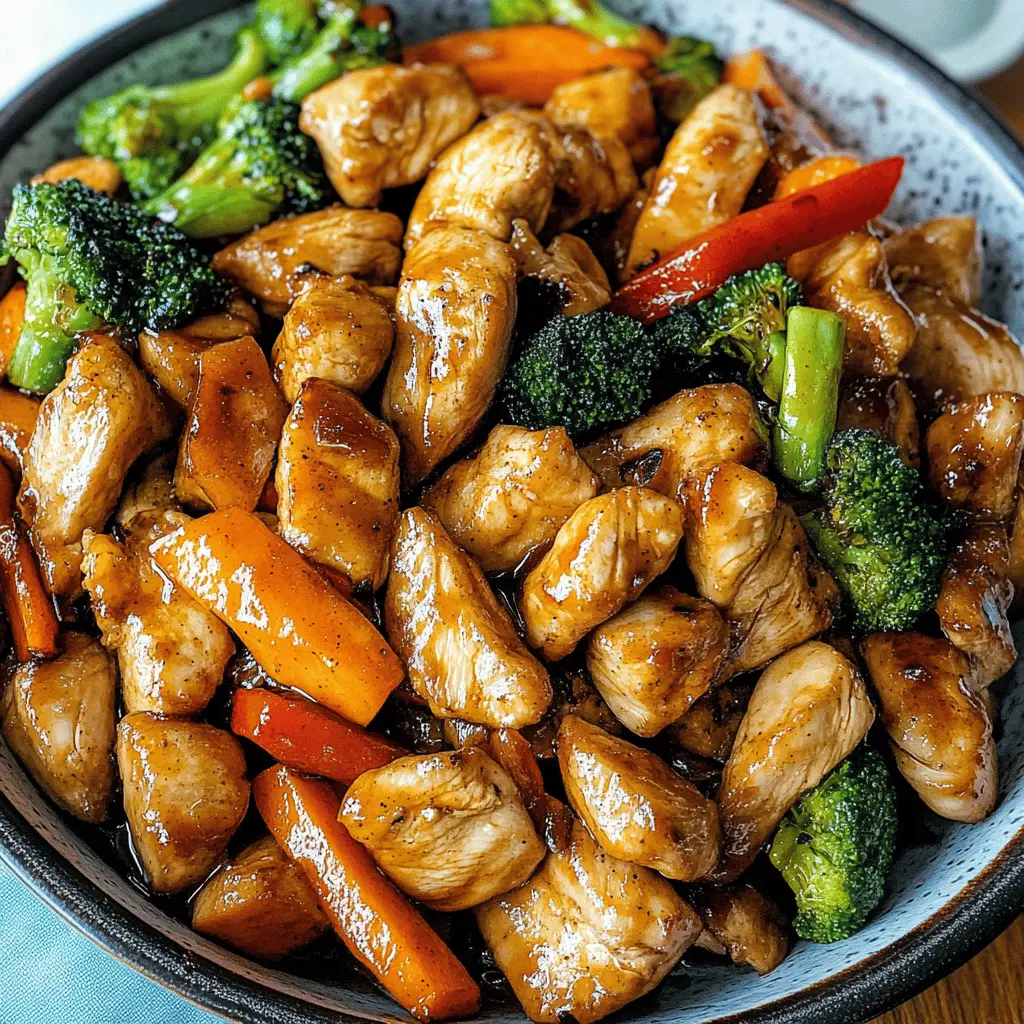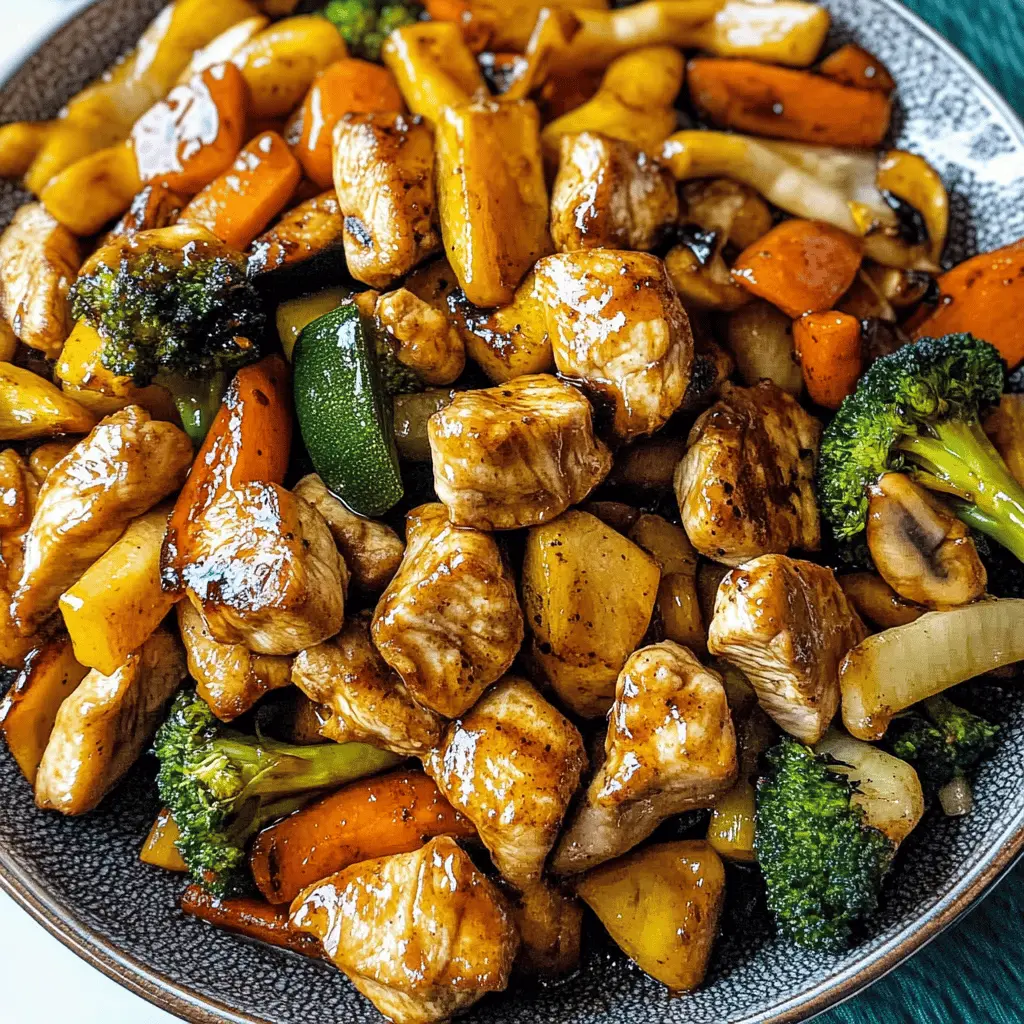This Hibachi Chicken and Vegetables dish is a fun and tasty treat! Juicy chicken is mixed with colorful veggies, all cooked to perfection on a hot grill. It’s a real crowd-pleaser!
You know what’s great? You can pretend you’re at a fancy restaurant while making this at home. Plus, it’s quick to whip up for dinner, and your family will love it! 🥢
Key Ingredients & Substitutions
Chicken: You can use boneless, skinless thighs for juicy flavor or chicken breasts for a leaner option. If you’re looking for a plant-based alternative, try tofu or tempeh for a similar texture!
Soy Sauce: Soy sauce adds a salty depth. If you’re gluten-free, opt for tamari instead. Coconut aminos are a great soy sauce substitute if you’re avoiding soy entirely.
Sesame Oil: This oil gives a lovely nutty flavor. If you don’t have it, olive oil or canola will work, though you’ll miss that unique taste. Toasted sesame oil is a fantastic addition for a stronger flavor, just use it sparingly.
Vegetables: Feel free to mix and match veggies! Instead of broccoli, use snap peas or green beans. If you don’t like mushrooms, zucchini or asparagus work well. Seasonal vegetables can also boost freshness!
How Do I Ensure My Chicken is Juicy and Flavorful?
Marinating the chicken is the key to flavor and tenderness. Aim for at least 30 minutes, but longer is better for richer taste. When cooking, keep the heat medium-high for a good sear without overcooking.
- Combine chicken with a marinade of soy sauce, sesame oil, garlic, and ginger.
- Let it marinate in the fridge – the longer, the more flavor!
- Cook in batches if needed to avoid overcrowding the pan, which can steam rather than sear.
What’s the Best Way to Stir-Fry Vegetables for Crispness?
To keep your veggies crisp, follow a few simple tips. Use high heat and make sure to prep all your veggies beforehand since things move fast during stir-frying.
- Use a large skillet or wok for even cooking.
- Heat the oil until shimmering before adding garlic and ginger for maximum flavor.
- Don’t overcrowd the pan – stir-fry in batches if necessary.
- Keep stirring for an even cook, usually about 5-7 minutes is perfect for tender-crisp veggies.

How to Make Hibachi Chicken and Vegetables
Ingredients You’ll Need:
For the Chicken:
- 1 lb boneless, skinless chicken thighs or breasts, cut into bite-sized pieces
- 3 tablespoons soy sauce
- 2 tablespoons sesame oil
- 1 tablespoon garlic, minced
- 1 teaspoon ginger, minced
- Salt and pepper to taste
For the Vegetables:
- 1 cup broccoli florets
- 1 cup carrots, sliced into matchsticks
- 1 cup bell peppers (red, yellow, or orange), sliced
- 1 cup onion, sliced
- 1/2 cup mushrooms, sliced
- 2 tablespoons soy sauce
- 2 tablespoons vegetable oil (for stir-frying)
- 1 tablespoon garlic, minced
- 1 tablespoon ginger, minced
- Optional: 1 tablespoon sesame seeds for garnish
How Much Time Will You Need?
This recipe takes about 10 minutes of prep time and 30 minutes for cooking. You’ll need an additional 30 minutes for marinating the chicken. Altogether, set aside around 1 hour and 10 minutes for this delicious Hibachi Chicken and Vegetables!
Step-by-Step Instructions:
1. Marinate the Chicken:
In a bowl, mix together the chicken pieces, soy sauce, sesame oil, minced garlic, minced ginger, and a pinch of salt and pepper. Make sure all the chicken is well coated. Cover the bowl and place it in the refrigerator for at least 30 minutes to let the flavors soak in.
2. Prepare the Vegetables:
While your chicken is marinating, wash and chop all your vegetables. Slice the broccoli, carrots, bell peppers, onion, and mushrooms into bite-sized pieces so they cook evenly. Having them ready will make it easier when you start cooking!
3. Cook the Chicken:
Heat a large skillet or hibachi grill over medium-high heat. Add 1 tablespoon of vegetable oil once it’s hot. Carefully add the marinated chicken in a single layer (you may have to do this in batches). Cook for about 5-7 minutes, flipping the chicken now and then until it’s cooked all the way through and turns golden brown. Once done, remove the chicken from the skillet and set it aside on a plate.
4. Stir-Fry the Vegetables:
In the same skillet, add the remaining tablespoon of vegetable oil. Toss in the minced garlic and ginger; sauté them for about 30 seconds or until they smell amazing. Now, throw in the broccoli, carrots, bell peppers, onion, and mushrooms. Stir-fry everything for about 5-7 minutes, or until the veggies are tender yet still crisp. They should look vibrant and colorful!
5. Combine Chicken and Vegetables:
Now it’s time to bring it all together! Return the cooked chicken to the skillet with the vegetables. Pour the additional soy sauce over everything and stir to combine well. Cook for another 2-3 minutes until everything is warmed through and coated in flavor.
6. Serve:
Transfer your hibachi chicken and vegetables onto a serving platter. If you like, sprinkle some sesame seeds on top for an extra touch! Serve this delightful dish hot, and enjoy it with a side of steamed rice or noodles. Happy eating!

Can I Use Different Types of Chicken for This Recipe?
Absolutely! You can use either boneless, skinless chicken thighs or breasts as listed. If you prefer dark meat, chicken thighs will provide a richer flavor. Alternatively, you can also use shrimp or tofu for a variation, just adjust cooking times accordingly, especially for shrimp which cooks faster!
What Can I Substitute for Soy Sauce?
If you’re looking for a gluten-free option, you can use tamari instead of soy sauce. Coconut aminos are another great gluten-free and lower-sodium alternative. For a different flavor profile, try mixing equal parts of balsamic vinegar and water, although this will change the dish’s taste slightly.
How to Store Leftovers
Store any leftover hibachi chicken and vegetables in an airtight container in the refrigerator for up to 3 days. To reheat, simply use a microwave or heat gently on the stove. Adding a splash of water or extra soy sauce can help revitalize the dish when reheating!
Can I Add Other Vegetables to This Dish?
Definitely! Feel free to get creative with your veggies. Snap peas, zucchini, or baby corn would be great additions! Just keep in mind the cooking times to ensure all vegetables are tender but still crisp.